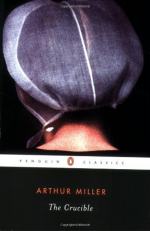|
This section contains 891 words (approx. 3 pages at 400 words per page) |

|
The Crucible Summary & Study Guide Description
The Crucible Summary & Study Guide includes comprehensive information and analysis to help you understand the book. This study guide contains the following sections:
This detailed literature summary also contains Topics for Discussion and a Free Quiz on The Crucible by Arthur Miller.
The Crucible is a dramatic work by American playwright Arthur Miller. The play, first produced on Broadway in 1953, illustrates the story of the Salem witch trials of 1692-1693. Miller's tragic drama follows the protagonist John Proctor and his plight for justice amongst mass hysteria, and metaphorically examines the motivations and corruption of the McCarthy era in Miller's own time.
The play opens with Reverend Samuel Parris standing over the bedside of his daughter, Betty, who has fallen into a comatose-like state. The night before, Reverend Parris discovered Betty, her cousin Abigail, and several other village girls dancing in the woods with Parris's slave, Tituba. Reverend Parris questions Abigail as to the night's events, and Abigail denies any claims of witchcraft, insisting the girls were only dancing. Parris requests Beverly summon Reverend Hale, an expert in the subject of the demonic arts, to examine Betty for signs of the Devil.
When the adults leave the room, Abigail, along with Mercy Lewis, attempt to rouse Betty. When Betty awakens, she is hysterical and claims Abigail drank blood the night before in a ritual designed to kill Elizabeth Proctor. Abigail slaps and threatens Betty into submission, and tells the rest of the group if they admit anything happened that night besides dancing, she will hunt them down in the night and do them great harm.
John Proctor arrives and chastises his servant, Mary Warren, for being away from his home and her duties. When Proctor and Abigail are left alone, Abigail pleads to Proctor to give her a "soft word" and alludes to a previous affair between the two (Act I, p. 22). Proctor resists Abigail's advances, telling her it is over between them, which leads Abigail to rail against Proctor's wife, claiming she is slandering her in the town.
Betty again awakens in hysterics upon hearing a psalm sung below, and several townspeople rush to her room. Rebecca Nurse, an older respected woman in the community, stands above Betty until she returns to sleep, and then comments that the child is likely only experiencing a passing illness, and rushing to the conclusion of witchcraft is a dangerous action.
Reverend John Hale arrives and examines Betty, consulting a number of books to determine if she is marked by the Devil. The Putnams, another family in Salem, also have an afflicted child, and Hale goes to examine Ruth Putnam as well. Upon hearing of Reverend Parris's discovery the night before, Reverend Hale insists upon questioning Abigail. Hale bombards Abigail with questions about the actions and events which took place during the girls' "ritual," and eventually Abigail breaks down and names Tituba as a conjurer of the Devil.
Tituba is brought forward and is beaten and threatened with hanging for her evil deeds until she too finally breaks and begins naming the names of those she believes to be possessed by the Devil. Abigail joins in and soon all of the girls are hysterical and exclaiming the names of everyone they believe to be witches in Salem.
John Proctor and his wife, Elizabeth, discuss the events and the fact that fourteen people have been arrested for witchcraft in the town. Elizabeth begs John to go to Ezekiel Cheever, a town authority, and reveal the information he learned from Abigail—that the dancing had nothing to do with witchcraft. When Elizabeth discovers Proctor was alone with Abigail when she told him this information, she turns cold with distrust. Proctor's internal battle over his past affair haunts him and he claims it has been seven months since Abigail left as their servant and he has not seen her since then. Mary Warren returns from court and is lambasted by Proctor for abandoning her duties at home. Mary, though, asserts she is now an official of the court and her duties are of a higher cause.
Reverend Hale arrives at the Proctor home to question Elizabeth and John Proctor regarding their moral character, as Elizabeth's name has been mentioned in the court. Shortly afterward, Cheever and Herrick arrive to arrest Elizabeth, claiming Abigail Williams fell ill due to Elizabeth's having put a curse on her with the use of a poppet.
John Proctor convinces Mary Warren to stand in court against Abigail and the others, claiming their accusations were false. Mary and Proctor present evidence to the court, but Abigail's power has grown stronger, and she and the other girls begin seeing "visions" and chaos breaks out in the courtroom. Proctor confesses to his affair with Abigail, but when Elizabeth is summoned to verify the claim, she refuses to denounce her husband and so lies, discrediting Proctor's confession. Abigail psychologically regains control over Mary Warren, who then turns against Proctor, calling him an agent of the Devil. Proctor is arrested and incarcerated.
The following fall, twelve prisoners have been executed and seven remain in jail. Reverend Hale has denounced the trial and stands by those accused, attempting to get them to confess in order to save their lives. Elizabeth is brought to Proctor's cell in the hope she will convince him to confess and save himself. Proctor decides to lie in order to save his life and family, but when faced with the fact that his confession will be nailed to the church doors, he retracts his confession and chooses to die an honest man.
Read more from the Study Guide
|
This section contains 891 words (approx. 3 pages at 400 words per page) |

|



